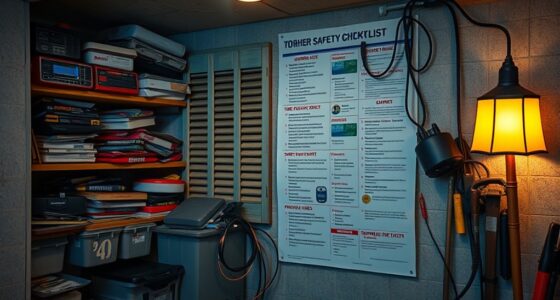During a heat wave power outage, you need to precisely calculate your essential devices’ power needs to stay safe and comfortable. Start by listing critical appliances like fans, refrigerators, and medical devices, then check their wattage and total them up. Consider backup options like generators or batteries, factoring in surge power and runtime. Planning your energy supply now helps avoid surprises later—stick around to find out exactly how to do these calculations effectively.
Key Takeaways
- Calculate total wattage of essential devices to determine backup power needs and avoid overloads during outages.
- Account for surge wattage of appliances like refrigerators and AC units to size generators and inverters properly.
- Estimate peak power demand by summing simultaneous device wattages for effective solar panel and generator sizing.
- Regularly review and update power consumption calculations to accommodate future expansions and avoid system overloads.
- Prioritize energy-efficient appliances and renewable sources to reduce total load and enhance outage resilience.
Identifying Essential Appliances and Devices
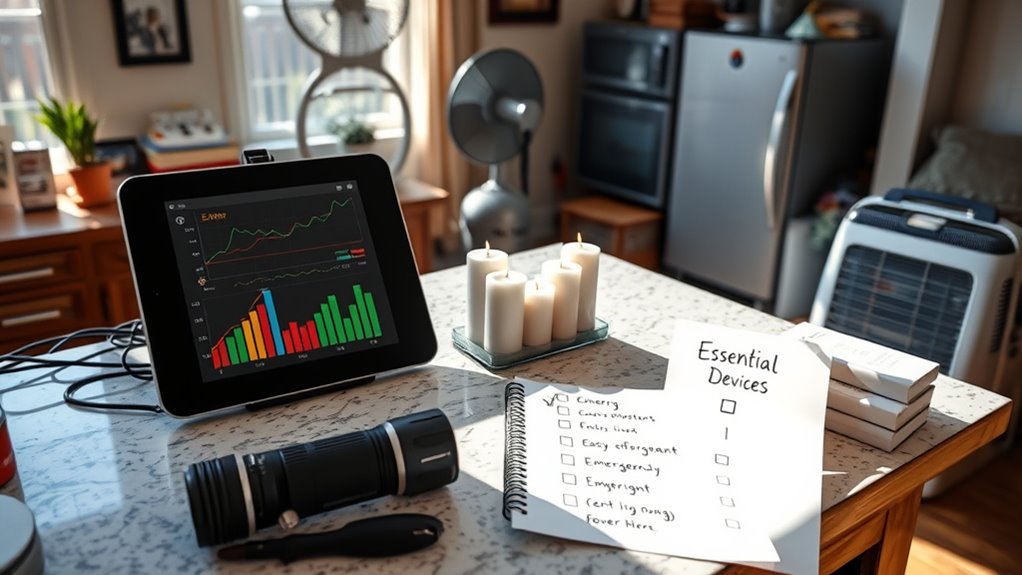
During a heat wave power outage, it’s crucial to identify which appliances and devices are essential to your daily life. Start by listing items you need to stay safe and comfortable, like fans, refrigerators, and medical devices. Portable generators can provide backup power for these essentials, especially if you need to keep perishable food or medical equipment running. Solar panels are an eco-friendly option to supplement your power supply, helping you charge devices or power small appliances during extended outages. Focusing on devices that support your health and safety, such as air conditioning units or fans, and those that preserve food. Prioritizing these essentials ensures you use your backup power effectively and stay comfortable until the power’s restored. Regularly assessing and reorganizing your setup can help you maximize space and ensure quick access to critical items during emergencies.
Calculating Power Consumption of Your Devices

To prepare for a potential power outage, you need to know how much electricity your devices use. By checking their wattage ratings, you can estimate your total power needs and plan for peak usage times. This way, you’ll be ready to keep essential devices running smoothly during an outage. Additionally, understanding the power consumption of your projector can help you determine if it can operate on your backup power sources during an outage.
Device Wattage Ratings
Have you ever wondered how much energy your devices use? To find out, check their wattage ratings, usually found on labels or in manuals. Wattage indicates how much power a device consumes in watts (W). This helps you estimate energy needs during outages, especially when considering solar efficiency and battery chemistry. Keep in mind that devices with high wattage draw more power, impacting your backup plans. For example, a small fan might use 50W, while a refrigerator could need 150W or more. Knowing these ratings allows you to prioritize essential devices. Understanding power consumption is vital for calculating overall energy usage and ensuring your backup power sources are sufficient to keep critical devices running during outages.
Total Power Estimation
Once you know the wattage ratings of your devices, the next step is to estimate their total power consumption. Add up the wattages of all appliances you plan to run simultaneously to get a clear idea of your overall energy needs. Consider how long each device runs to calculate total energy use in watt-hours or kilowatt-hours. If you’re planning for backup power, factor in your solar panel and wind turbines’ output capacities. Solar panels generate power during the day, so account for sunlight hours, while wind turbines can provide steady energy if the wind blows consistently. By accurately estimating your total power consumption, you’ll better understand how much renewable energy you’ll need to keep essential devices running during an outage. Additionally, understanding your bedroom energy requirements can help you optimize your setup for comfort and efficiency.
Peak Usage Planning
Understanding the power consumption of your devices during peak usage is essential for effective planning. To do this, list all your critical appliances, including air conditioners, refrigerators, and electronics. Check their wattage ratings and estimate how long each runs during peak periods. This process helps you determine your total power needs, so you can size your solar panels accordingly. If your solar setup isn’t enough, plan for grid backup options to cover shortfalls. Knowing your peak demand allows you to prioritize devices and avoid overloading your system. It also helps you decide when to use energy-efficient appliances or temporarily reduce usage. Proper peak usage planning ensures your power system remains reliable during heat waves, preventing outages and keeping your home comfortable. Understanding SDLC principles can also improve your planning by clarifying how to integrate backup solutions within your overall energy strategy.
Estimating Total Wattage Needed

To guarantee your power system can handle the increased demand during a heat wave, you need to accurately estimate the total wattage you’ll require. Start by listing all essential appliances and devices, noting their wattage ratings. Consider your solar panels’ output and confirm your inverter capacity can support the combined load. If your appliances total 3,000 watts, your inverter should handle at least that amount, with some margin for safety. Remember, solar panels generate variable power depending on sunlight, so plan for peak wattage needs during the brightest part of the day. Proper wall organization can help you keep track of your energy-efficient appliances and reduce unnecessary consumption. By calculating the total wattage needed and matching it with the inverter capacity and solar panel output, you ensure a reliable power supply when outages or high demand strike.
Understanding Battery Capacity and Runtime
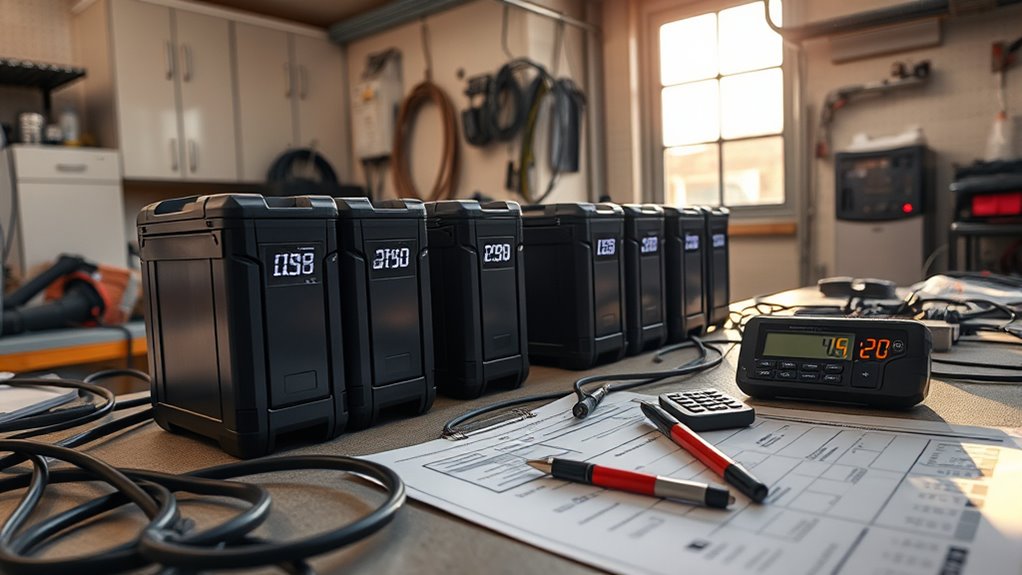
Knowing your battery capacity is essential to guarantee your backup power lasts through outages or high-demand periods. Understanding how much energy your battery can store helps you plan effectively and avoid unexpected shutdowns. Battery longevity depends on proper usage and maintaining an ideal charge cycle, which extends its effective runtime. To estimate how long your battery will power your devices, perform a runtime estimation by dividing the battery’s total capacity (measured in watt-hours) by the load’s wattage. This calculation provides a clear idea of how long your power supply will last during an outage. Keep in mind that actual runtime may vary based on factors like device efficiency and battery condition, so regular maintenance and accurate capacity awareness are key for reliable backup power. Additionally, understanding the type of headphone jack your devices use can help ensure proper connectivity during emergencies or routine use.
Determining Generator Size Requirements
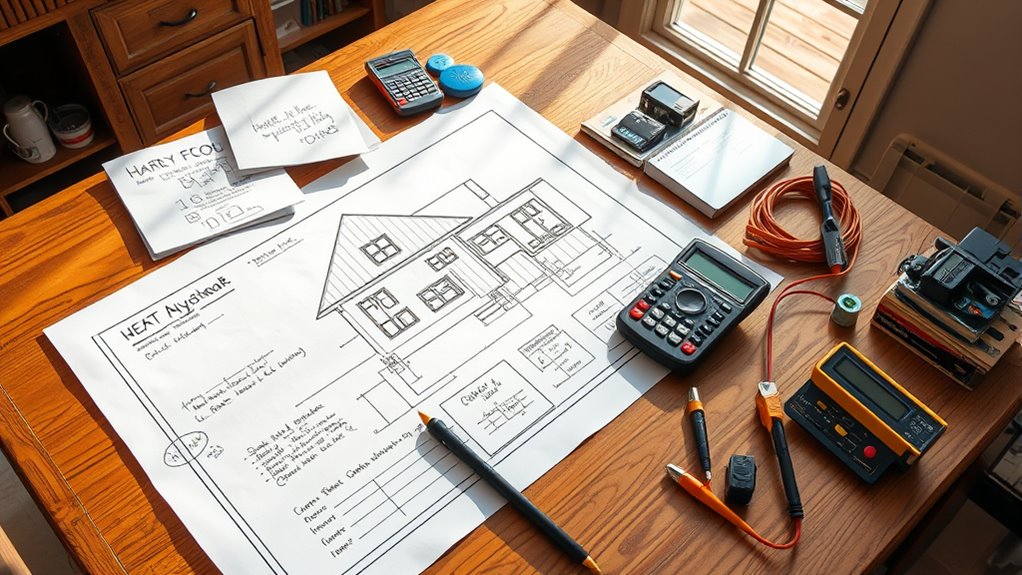
To ascertain the right generator size, you need to calculate your total power needs, including essential appliances and systems. Remember to account for starting loads, which require extra power during startup. Also, consider any future expansion to ensure your generator can handle increased demands down the line. Using performance metrics such as maximum pressure and spray pattern can help determine the appropriate capacity for your painting equipment.
Calculating Total Power Needs
Before selecting a generator, you need to determine your total power needs. Start by listing essential appliances and devices, like fans, refrigerators, and lights. Next, calculate their wattage requirements, paying attention to startup surges for items like refrigerators or sump pumps. Finally, factor in your solar panels and inverter sizing to guarantee compatibility.
- List all critical devices and their wattages
- Sum the continuous and surge wattages for each item
- Match the total with your solar panel system and inverter capacity
This process guarantees your generator can handle your peak load, especially considering the inverter size needed for your solar panels. Accurate calculations prevent overloads and ensure your power system remains reliable during a heat wave outage.
Accounting for Starting Loads
When sizing your generator, accounting for starting loads is key to guaranteeing it can handle the initial surge of power needed by certain appliances. Devices like refrigerators, well pumps, and air conditioners draw a much higher current when starting up, which can overwhelm a generator if not properly accounted for. To prepare, identify the starting wattage for each item and add these figures to your total running load. If your power setup includes solar power, remember that starting loads may briefly exceed your solar output, making a generator essential during outages. Relying solely on grid dependency might reduce the risk, but during a heat wave outage, a generator ensures stability. Properly sizing your generator prevents overloads and keeps your critical appliances running smoothly during emergencies. Additionally, understanding inverter generator capabilities can help you select a model that efficiently handles these surge requirements without wasting fuel or damaging appliances.
Including Future Expansion
Considering future expansion is essential when determining your generator size to avoid outgrowing your power system too quickly. Planning ahead guarantees you can add solar integration or achieve grid independence later without costly upgrades. To do this effectively, you should: 1. Assess your current power needs and estimate increased loads for future appliances or systems. 2. Factor in potential solar panel additions that could reduce grid reliance and support power demands. 3. Select a generator with capacity slightly above your current requirements to accommodate expansion without sacrificing efficiency. Additionally, understanding sustainable technology can help you choose more adaptable and eco-friendly solutions for your energy needs.
Factoring in Surge Power and Starting Loads
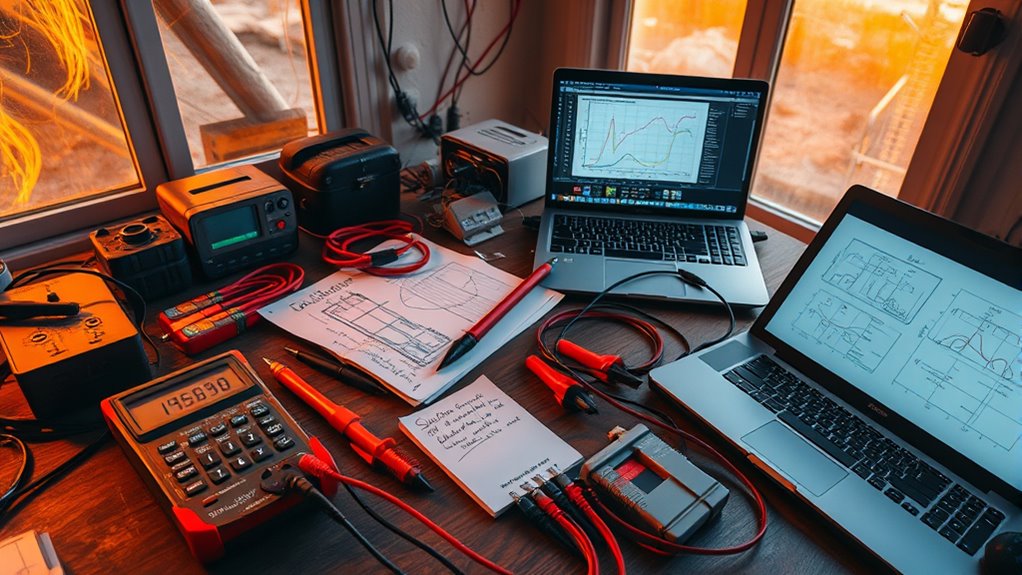
To guarantee your power system can handle peak demands during a heat wave, you need to account for surge power and starting loads. Devices like refrigerators, air conditioners, or pumps draw higher power when they start. Failing to include this surge can overload your inverter or solar panels. Proper inverter sizing ensures you can support these initial spikes without failure. Here’s a quick overview:
| Device | Typical Power (W) | Starting Power (W) |
|---|---|---|
| Refrigerator | 150 | 600 |
| Air Conditioner | 1500 | 4500 |
| Pool Pump | 1000 | 3000 |
| Solar Panels | 300W each | N/A |
| Inverter Sizing | 2000W | 6000W |
Make sure your inverter can handle these starting loads for reliable operation.
Accounting for Future Power Needs
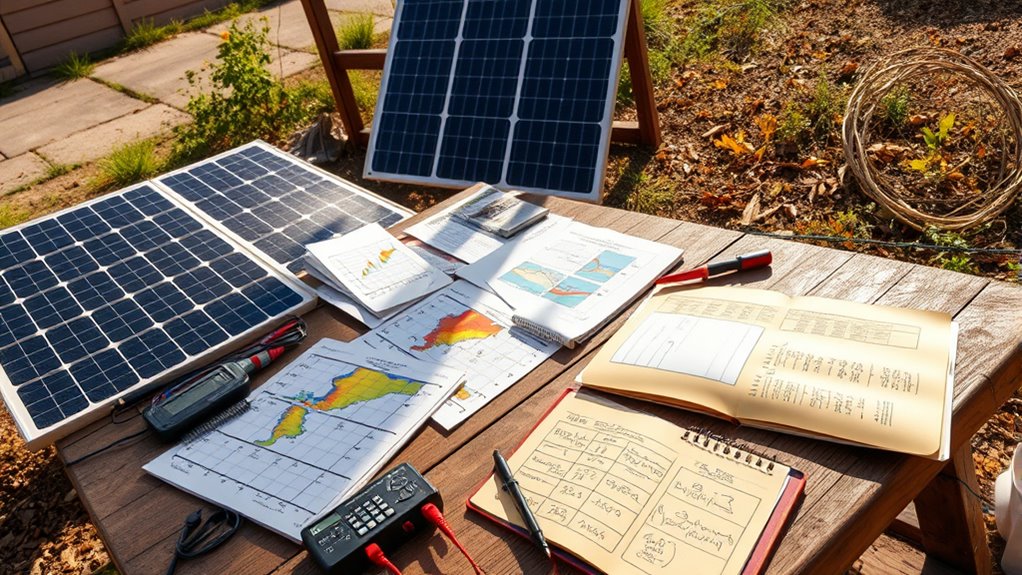
To guarantee your power system can handle future demands, you need to estimate peak usage accurately. Planning for growth involves predicting how your energy needs might increase over time. By doing so, you can avoid shortages and keep the lights on during heat waves.
Estimating Peak Demand
How can you accurately estimate peak demand to make certain the power grid can handle future heat waves? Start by analyzing historical data, noting how usage spikes during past heat events. Then, consider projected population growth and increased use of renewable sources, which impact future demand. Lastly, incorporate climate models predicting hotter summers, which could elevate peak loads.
To ensure grid reliability, you should:
- Use predictive analytics that factor in climate trends and consumption patterns.
- Account for the integration of renewable sources, which can fluctuate but are essential for sustainable growth.
- Regularly update demand forecasts to adapt to changing conditions, reducing the risk of overloads during heat waves.
Accurate estimation helps you plan capacity, ensuring the power grid remains resilient and reliable in extreme weather.
Planning for Growth
Planning for growth involves projecting future power needs based on current trends and anticipated developments. As your community expands, consider how renewable sources can meet increased demand sustainably. Incorporate backup systems to ensure reliability during peak times or outages. Accurate forecasts help you allocate resources efficiently and prevent shortages during heat waves. Use the table below to understand potential growth factors:
| Factor | Impact |
|---|---|
| Increased population | Higher overall energy consumption |
| Adoption of renewables | Reduced reliance on fossil fuels |
| Infrastructure upgrades | Need for expanded capacity |
Considering Energy Efficiency and Conservation
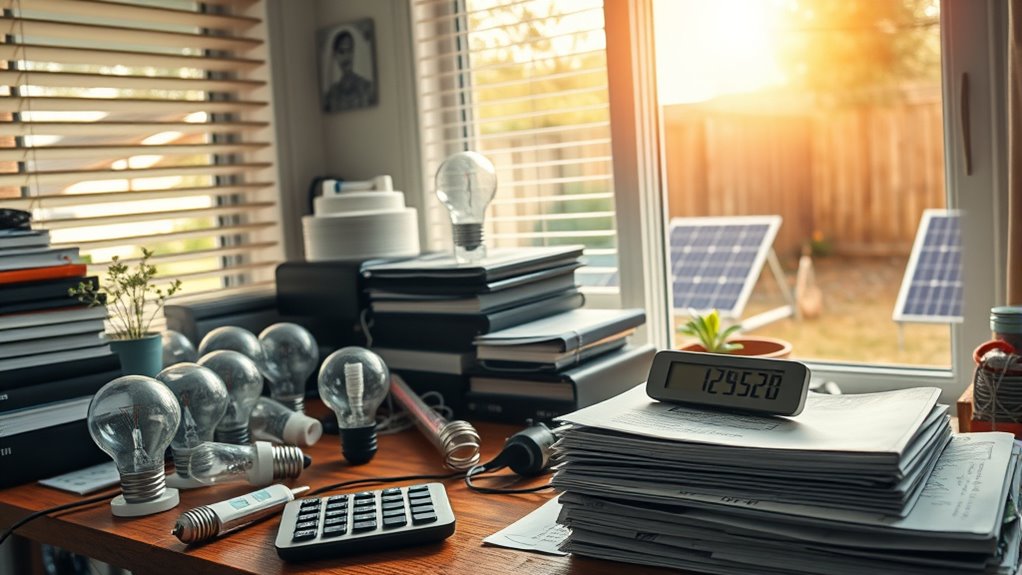
During a heat wave, focusing on energy efficiency and conservation can substantially reduce the strain on the power grid and help prevent outages. You can make a significant impact by adopting smart grid technologies and maximizing renewable sources.
During heat waves, conserve energy to reduce grid stress and prevent outages.
- Use energy-efficient appliances and LED lighting to lower demand during peak hours.
- Set your thermostat higher or use fans to reduce cooling energy consumption.
- Support the integration of renewable sources like solar panels to supplement power needs and ease grid load.
Planning for Power Distribution and Outlets
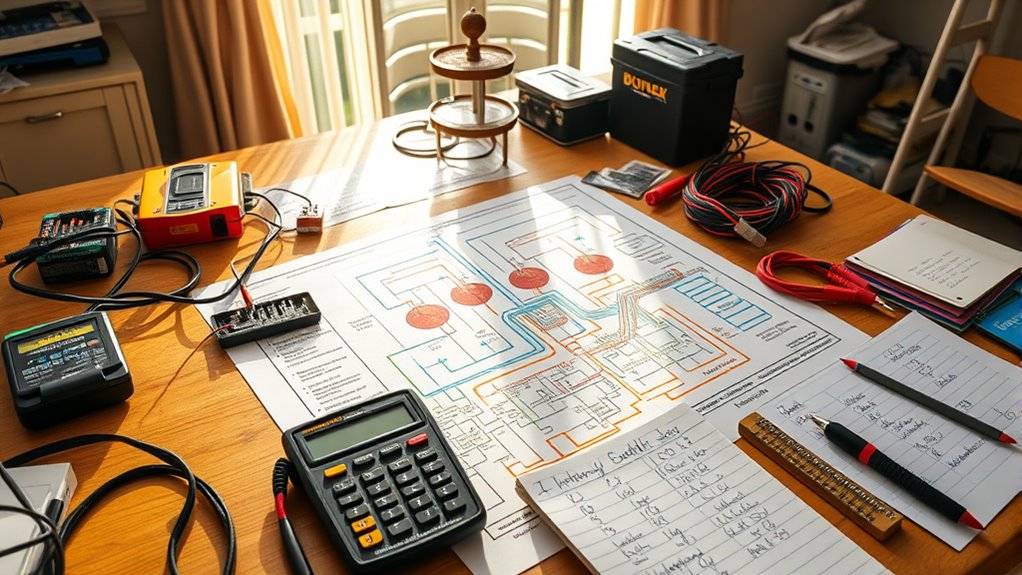
To guarantee your home is prepared for a heat wave power outage, it’s vital to strategize the distribution of electricity and the placement of outlets. Start by planning where to install solar panels, ensuring they’re positioned for maximum sun exposure. Proper inverter selection is essential; choose an inverter that matches your solar panel capacity and can handle your essential appliances. Distribute outlets thoughtfully, prioritizing those near your backup power sources and high-usage areas. Use surge protectors to safeguard sensitive devices. Consider installing dedicated circuits for critical appliances to prevent overloads. Efficient planning ensures your power distribution is balanced and reliable, reducing the risk of outages. By integrating solar panels with the right inverter and outlet setup, you’ll be better prepared to maintain essential functions during a heat wave outage.
Reviewing and Validating Your Power Calculations

Before relying on your power setup during a heat wave outage, it’s crucial to review and validate your calculations to guarantee they are accurate. Proper validation ensures your system can handle the load without overtaxing the power grid or causing voltage regulation issues.
- Double-check your load calculations to confirm your power needs match your generator or backup system capacity.
- Review voltage regulation margins to prevent voltage drops that could damage appliances or reduce efficiency.
- Cross-verify your calculations with reputable sources or professional tools to catch errors before an emergency occurs.
Frequently Asked Questions
How Often Should I Update My Power Outage Preparedness Calculations?
You should update your power outage preparedness calculations at least once a year, especially after conducting an energy audit or making changes to your backup inventory. Regular updates ensure your plan remains accurate and effective. Keep track of seasonal shifts, new equipment, or changes in energy use. This proactive approach helps you stay prepared, avoid surprises, and maintain a reliable backup system during outages.
What Safety Precautions Should I Take When Using Backup Power Sources?
Think of backup power sources as your safety net—handle them carefully. Always follow generator safety guidelines, ensuring proper ventilation and avoiding overloads. When using batteries, wear gloves and eye protection to prevent accidents. Never run a generator indoors, and keep it away from windows or vents. Regularly inspect and maintain your equipment to prevent hazards. Prioritize safety to keep your home and loved ones protected during outages.
Can Renewable Energy Sources Like Solar Reduce My Power Outage Risks?
Yes, renewable energy sources like solar can mitigate your power outage risks. Solar benefits include generating electricity during outages if you have a battery backup system, providing some independence from the grid. However, renewable limitations mean solar alone might not cover all your needs during extended outages, especially on cloudy days or at night. Combining solar with other backup solutions ensures a more reliable power supply during emergencies.
How Do I Prioritize Devices During a Power Outage?
You might think all devices are equal, but during a power outage, prioritizing is key. Start with essential devices like your fridge, medical equipment, and communication tools. Use device priority to allocate energy efficiently, and practice good energy management. Ironically, the gadgets you rely on daily can be the last to get power, so plan ahead. Keep a list, conserve energy, and guarantee your critical devices stay powered when it matters most.
What Are Common Mistakes to Avoid in Power Outage Planning?
Avoid common mistakes like neglecting generator maintenance, which can cause failures when you need it most. Don’t forget to verify power cord safety; damaged cords pose fire hazards and can harm your equipment. Planning without considering these aspects risks safety and reliability. Always make certain your generator is in good condition, and use properly rated cords. This proactive approach keeps your power outage prep effective and safe.
Conclusion
By carefully calculating your power needs, you guarantee you’re prepared for any heat wave outage. For example, if you rely on a small fridge and a few fans, choosing the right generator size prevents surprises and keeps essentials running smoothly. Remember, skipping these steps could leave you without power when you need it most. Take the time now to plan, double-check your calculations, and stay comfortable and safe during extreme heat.


